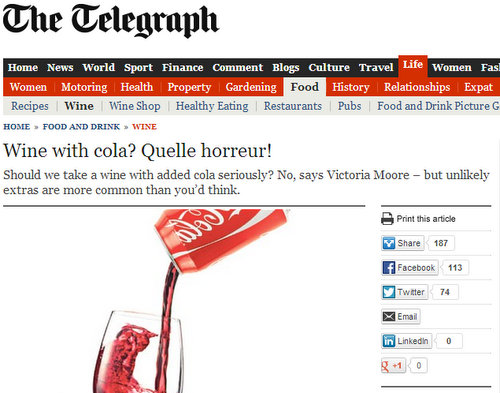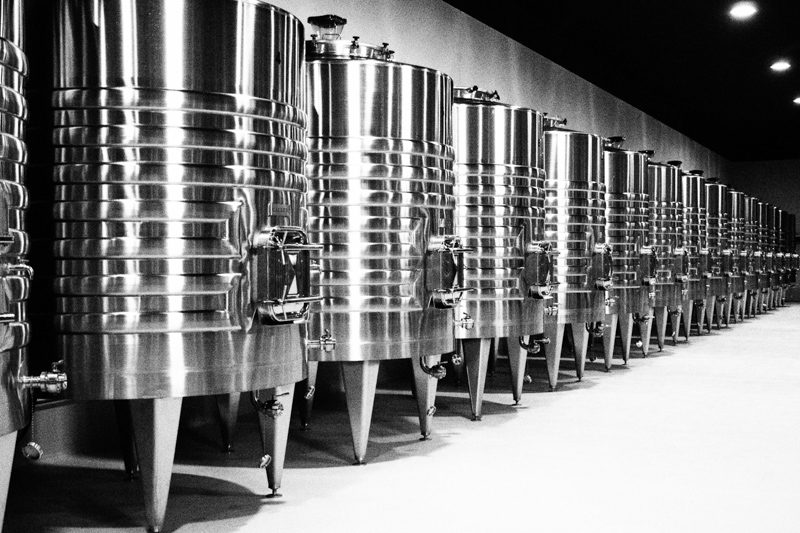Are flavoured wines the solution at the bottom end of the market?
Victoria Moore’s wine column focused this week on the phenomenon of flavoured wines. Apparently, they are on the rise. The French are falling for grapefruit-flavoured rosés and passionfruit-flavoured whites, and someone has just launched a red wine flavoured with cola. It has sparked quite a bit of discussion on Twitter.
Where do you stand on this?
From the discussions on Twitter, some people seem to want to cast those with opinions on this subject into one of two camps:
First, we have the die-hard traditionalists: those who stoutly defend wine as it is, who cling to tradition, and who are out-of-touch snobs who’d rather the wine category died altogether than compromise in this way.
Second, we have the enlightened liberals: those who see the need for progress, and embrace these sorts of wines at the bottom end of the market. They could bring new drinkers into the category, and why shouldn’t people enjoy wines with flavours that they like?
I am going to propose a third way. I suggest that a sensible approach to flavoured wines falls outside these two positions; that it’s possible to recognize the need for the wine category to innovate and embrace new consumers, without taking what I fear is a perilous path towards the erosion of wine as a privileged alcoholic beverage. Let me explain.
Wine is special. Among alcoholic beverages, it occupies a privileged position, and is uniquely associated with the table in a way that other drinks aren’t. Whether or not it deserves this special place is a separate question. But it does have it at present, and it doesn’t want to lose it.
Wine is legally protected. You can only call wine wine if it is made from freshly crushed grape juice, and you aren’t allowed to add any flavourings to it. If you do, you have to label it as a wine-based alcoholic beverage. This is important. If a wine is made from fruits other than grapes, it is called a fruit wine.
If we were to change this, and were to allow wine to be called wine when it has had flavourings added, then we would be in trouble. It will be much cheaper to make commercial wines by such means than by using only fresh grapes. And once commercial wines are made in this way, who’s going to stop producers using flavourings for more expensive wines? How would consumers ever know that these now-legal additions are being made to their wine?
Suddenly, you can envisage a scenario where the commercial end of wine becomes even more of a horror show than it is at the moment. There are many leading brands that I would hate to drink, but at least I know they are made from fresh grapes and don’t have flavouring added. Wine, in this sense, is still unique and special. Allow flavourings, and it could rapidly lose its privileged position in society, and that would be a disaster for the wine industry as a whole.
So while it seems liberal and progressive to embrace flavoured wines, I think they’re a huge mistake. You can innovate without compromising the essence of wine’s nature, as the recent success of Moscato and Sparkling Sauvignon Blanc has shown.
So, to summarize in a sentence. Cheap commercial wine is already pretty bad: anyone who wants to make it worse must be completely mad.
13 Comments on Are flavoured wines a good thing, or completely evil?


Hi Jamie, I came across your blog when adding interests to Feedly. I say hear, hear to your closing summary! Is the wine industry really so desperate to attract 18 year olds that they will sell a product that doesn’t even taste like wine?
Jamie, a well timed posting. Flavoured wines are also becoming of interest in the Nordic countries, and of course throughout history wine has often been improved or flavoured with herbs, resin, spirit and so forth.
I tend to think that there could be wide acceptance of these types of products without harming the wine market, so long as they are clearly marked as something other than wine (such as alcoholic grape drink and not wine based beverage) and allowed to be marketed and sold in a way that separates them from the wine category.
In the UK its become clear that the bottom end of the market (let’s say around £4 per bottle) is doing both a disservice to customers in leading them to believe that they are getting something with the attributes of real wine for a bargain price, and also producers for whom these prices are a virtual guarantee to lose money – even when the wine is stretched further than a Djokovic backhand.
You could argue that many consumers at these price levels would prefer the taste and appeal of a flavoured wine over a non-descript, bland, generic offer that highlights green, over-cropped, dilute fruit characters, perhaps hints of baggy reduction or baked oxidation, and at best a lick of fake caramel oak. Neutral, textured alcoholic water doesn’t appeal to me, and maybe is not so appealing to the bloke down the road either, and wines like this harm the image of the real stuff. Ask anyone trying to sell premium Pinot Grigio/Pinot Gris.
By leaving this sector of the market to alcoholic flavoured drinks, you’d release the damaging ballast on genuine wine and provide some real consumer clarity as to what constitutes a flavoured beverage and something that’s decent and honestly made wine for which you should be paying higher prices.
In the end people and the market will decide what they prefer to drink. Perhaps flavoured wine will be just like flavoured water – pointless and nothing more than another niche or fad. But if it strengthens people’s perceptions of genuine wine then let it have its day in the sun, and we’ll see who’s still batting at the end of it.
Good piece, Jamie. I don’t agree with all of what you’re saying, but I do appreciate your capacity to review the topic from different angles, even if you don’t like those angles.
Yours,
Damien
I agree Jamie, there is room for a third opinion. My main gripe is that it is putting the younger generation of wine drinkers in a ‘sweet’ box, something which really irritates me. I totally agree that innovation in product and wine-making skills is a better way of encouraging younger drinkers to explore the market without compromising on what we want them to get into in the first place.
Cheers,
Emma
Good article Jamie. I agree with you that “wine” is special in that it is made only from fermented grapes and that is what makes it so interesting. That the flavours of the terroir can come out.
Flavouring wine with other stuff is not new. I live 5 minuted from Thuir, where a whole empire was created on flavoured wines in the 19th century – Dubonet, Byrrh, Suze, Vermouth etc. None of these drinks were labelled as wine and people didn’t confuse them with wine. In my fridge I have a Muscat flavoured with coconut and pineapple. It’s pretty nice. Nobody is going to confuse it or compare it with Muscat de Rivesaltes but they might prefer it, so what?
I feel that these flavoured wines will improve the wine market. They may take market share from the adulterated brands you describe. Good. They are not going to steal market share from proper wines. They will help define the difference between real wine and wine-based drinks.
You don’t find many adulterated cheap brands in Spain. Why not? Because they have Sangria.
Jamie,
This reminds me of discussions about food products labeling in the U.S. and the legal requirements called the standard of identity. For something to be sold as ice cream in America, it has to have 10% milk fat. Yet there are plenty of other products that consumers perceive to be ice cream when in fact they don’t qualify…
Ice cream is a frozen food made from a mixture of dairy products, containing at least 10% milk fat.
“Reduced fat” ice cream contains at least 25% less total fat than the referenced product
“Light” ice cream contains at least 50% less total fat or 33% fewer calories than the referenced product (the average of leading regional or national brands).
“Lowfat” ice cream contains a maximum of 3 grams of total fat per serving (½ cup).
“Nonfat” ice cream contains less than 0.5 grams of total fat per serving
Wine is no different.
The overwhelming majority of consumers see wine as another beverage. A small segment of the population sees wine for its heritage, tradition and special place on the table. Call them core consumers who probably drink a bottle of wine/week.
I’m always in favor of giving consumers easy pathways to get into a category even if it offends those who believe that wine enjoyment is a serious activity and that it shouldn’t be diluted. Someone drinking one of these new products might grow into enjoying more traditional wines.
In my opinion, wine is what consumers define it to be not what regulations say it is.
Jamie, you say, ‘ You can only call wine wine if it is made from freshly crushed grape juice, and you aren’t allowed to add any flavourings to it. If you do, you have to label it as a wine-based alcoholic beverage. ‘
This is not true. The world’s largest producers of grape juice concentrate are wineries who use it to make vast oceans of wine sold commercially. Many entry-level commercial wines are made this way.
Also, flavour additives, whether derived from grapes, grape by-products or wood, or other natural or synthetic essences (linalool) are added to wine all of the time. Some of these additives are legal, others are used surreptitiously.
Wine has no privileged position but the one granted it by consumers, influenced by marketers. Two thousand years ago nobody ‘civilised’ drank wine made solely from crushed grapes. They mixed it with herbs, honey, seawater, spices and whatever else they favoured to change flavours. If you’re calling for adherence to tradition, then row your boat out at least 100 yards from shore, get yourself a bucket of seawater, and quit drinking that nouveau grapes-only stuff.
Thanks for the article. To each his own, however, you’ll never see me mixing wine with anything. My philosopy has been to always buy the best wine I can afford even if it means drinking less.
Spot on, Justin. I really don’t think this is an issue at all.
I am definitely on the “completely evil” end of the spectrum with flavoured wines. However, cheap cava mixed with home made elderflower cordial while watching Wimbledon was heavenly. However, is that a cocktail rather than flavoured wine?
Whatever happened to Kir or Cardinal made with top-notch cassis. Seems completely out of fashion these days, but worked well with the tart wines of the 1980s.
Good points about cocktails versus flavoured wines. I think they’re philosophically different. The former are fine.
Hi Jamie. Nice write up you have here. I belong to the school of thought that wine should be left the way they traditionally are. Though innovation and change is good, but in this case, old is better! I say NO to wine flavoring.